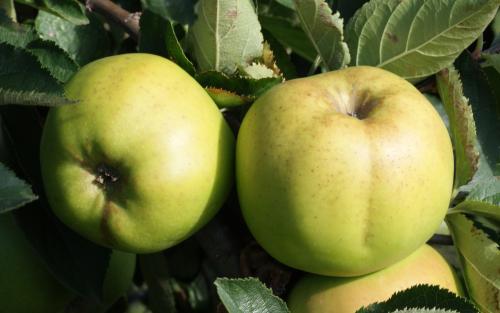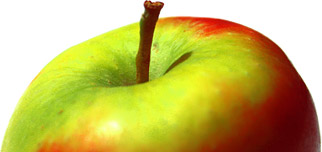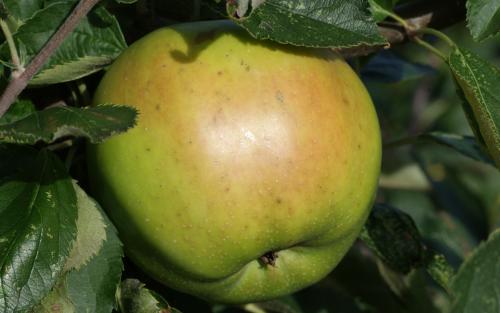Rhode Island Greening apple

Rhode Island Greening is well-known American heirloom apple variety, dating back to the 17th century. That makes it a very old apple, indeed there are not many European apples that can be traced back as far as Rhode Island Greening. Perhaps surprisingly Rhode Island Greening is not a rare antique variety grown by enthusiasts as a historical curiosity, as its vintage might suggest. Quite the opposite - it appears to have been a commercial variety from the outset and even today is still grown commercially in the north-eastern USA.
The main reason for this enduring success is that Rhode Island Greening is the definitive apple for American apple pie. It is one of those apples (like the English Bramley) that really benefits from cooking to bring out the full richness and sweetness of flavor. Whilst it can be eaten fresh after a period in storage, it is essentially a hard and uncompromising apple, far better in the kitchen.
Whereas the English like their culinary apples to dissolve into a puree or sauce, Rhode Island Greening - like most of the popular American cooking apples - tends to keep its shape when cooked.
Rhode Island Greening is a triploid apple variety - with three sets of chromosomes rather than the usual two sets (diploid). There is also a tetraploid form with four sets of chromosomes. The triploid form is the one most commonly planted and cannot pollinate other apple varieties. It takes longer than most apple varieties to come into bearing, but then goes on to become a relatively large tree with the potential to be very long-lived.
Rhode Island Greening apple identification images
All images copyright Orange Pippin unless otherwise stated.
USDA identification images for Rhode Island Greening
The identification paintings in the USDA Pomological Watercolor Collection span the years 1886 to 1942.
Citation: U.S. Department of Agriculture Pomological Watercolor Collection. Rare and Special Collections, National Agricultural Library, Beltsville, MD 20705.
Visitor reviews
- 06 Sep 2023 Alan ChoiniereEvery plant app. Says that my tree is a RI Greening Appletree, but the apples are ripe in July.
- 04 Jan 2023 Jennifer StadlerI fell in love with this variety of apple on our honeymoon in Door County Wisconsin in November of 1971. It cooks perfectly, if lovely to eat fresh, and the flavor is all the things you want from an apple. Sweet, tart, smooth with an excellent texture. My only complaint about this apple is that if you can't get to an orchard they are nearly impossible to find.
- 31 Oct 2016 Mike BettsMICHIGAN/KENT, United StatesI have an R.I. Greening in my orchard. 2016 was the first year for it to bear (one single apple). I protected it as if it were a gold nugget. A very beautiful apple indeed. Bright green ground. A nice reddish blush on the sunny side. I cut into that one apple about five days after harvest. It had a very pleasing tartness. Not one that would knock you off your seat. A slight citrus hint. I am really glad I planted this tree. I make a lot of baked apple deserts and am really excited to add this variety to my ingredient list.
- 09 Sep 2013 David PeragalloNEW HAMPSHIRE, United StatesComplex and nuanced flavor. We inherited a tree from some unknown fore bearer, thinking it was a crabapple. Once pruned it began to yield these large, pleasant apples that are so versatile, if not the most beautiful.
- 29 Oct 2012 Mary Esther PutnamUT, United StatesWe live in a small mountain community in Southern Utah. We had our apple trees trimmed last winter and the one tree which never produces many apples is loaded this year! They are tart, but withstood the 1st and 2nd freezes. Sooo, I decided to pick them and do research. They look like, taste like and cook like the description of Rhode Island greenings. I love the taste and the applesauce is wonderful. The tree is on property that has been in our family for 150 years, ancestors who came from the north eastern US. I wish I knew the history of our tree.!!!
- 28 Dec 2010 Sally Smoot34, United StatesFor a RI greening to be eaten raw you have to sprinkle it with salt, that will make it taste sweet. Trust me, I grew up eating and cooking with greenings. My mother, grandmother, and aunts prided themselves on making superb apple pies and they all swore by greenings as being the best, and necessary for a pie you could be proud of. You do need to add a lot of sugar for the pie to not taste too tart. In RI, in the 60's and 70's, you could find them everywhere but not anymore. I don't know why they fell out of favor, I miss them and have never found a good substitute.
- 11 Feb 2010 JimIL, United StatesOften large and firm fleshed. Not as juicy as some varieties, but keeps its shape well when cooked, and esteemed as a cooking apple. The old, untended tree we inherited from Great Grandpa often developed surface like honeydew. The Rhode Island Greenings grown by a friend show none of this.
- 20 Oct 2008 AdamARLINGTON, MASSACHUSETTS, United StatesThese may be favored for pies but they are also pleasant, if not remarkable, eating as well. Generally more tart than otherwise but mild, with hints of cider, grapes, and lemonade. I can't say exactly how long mine had been off the tree--at least a week--but it was still firm, if tender, and refreshing to eat.
Tree register
United States
- Alison Gardner in Albion, CALIFORNIA
- B. J. Converse in Searsmont, MAINE
- Bob in Chambersburg, IL
- Brendan in EVERETT, WA
- Chris Hastings in Swansea, MASSACHUSETTS
- Daniel Sims in Richmond, IN
- David Peragallo in Rindge, NEW HAMPSHIRE
- Florian Deisenhofer in Brush Prairie, WA
- Glenn Tremble in Trail, OREGON
- Harry Mccue in Lodi, NY/SENECA
- Holly in REHOBOTH, MASSACHUSETTS
- James Dierberger in Hebron, CT
- John R Hart in Woodstock, CT
- Kenneth Remfry in Topeka, KANSAS
- Lisa Schultz in Warwick, RHODE ISLAND
- Mark Campbell in Centerville, INDIANA
- Michelle Williams in Glenwood, SUSSEX COUNTY,NJ
- Mike in Dayton, OH
- Mike Betts in Grattan Township, MICHIGAN/KENT
- Mitch in Granger, IN
- Nathan Parker in Mount Shasta, CA
- Paul Grochowski in Floyd, VIRGINIA
- Richard Swanson in WATERFORD, CT
- Rick Simoniello in Storrs / Mansfield, CT
- Tim Cheney in Walpole, ME/LINCOLN
- Tom Parks in Holladay, UT
- Tom Scampoli in NORTH PROVIDENCE, RHODE ISLAND
United Kingdom
- Richard Borrie in York, YORKSHIRE
Canada
- Clive Rose in SALT SPRING ISLAND, BRITISH COLUMBIA
- Dan in Vittoria, ONTARIO
- Erik Nordenson in Cobourg, ONTARIO
- Stella Hiemstra in INVERARY, ONTARIO
New Zealand
- Giles in HAMILTON, WAIKATO
Switzerland
- Helmut Mueller in Neukirch, THURGAU
Spring blossom records for this variety
2016 season
- June 2016 - tree owned by B. in Searsmont, United States
- 14th April 2016 - tree owned by Kenneth in Topeka, United States
2013 season
- 19th May 2013 - tree owned by Richard in York, United Kingdom
Record your blossom dates in our Fruit Tree Register - more >>.
Harvest records for this variety
Origins
- Species: Malus domestica - Apple
- Originates from: Rhode Island, United States
- Introduced: 17th century
- UK National Fruit Collection accession: 1945-176
- We are grateful to Brogdale Farm - home of the UK National Fruit Collection - for providing samples of this variety.
Identification
- Country of origin: United States
- Period of origin: 1650 - 1699
- Flower colour: White
- Leaf colour: Green
- Popularity: Best sellers
- Annual cycle: Deciduous
Using
- Picking season: Late
- Keeping (of fruit): 3 months or more
- Flavour quality: Very good
- Flavour style (apples): Sharper
- Cooking result: Keeps shape
- Discoloration of fruit: No discoloration (Good for drying)
- Cropping: Good
- Fruit persistence: Normal ripening
- Food uses: Culinary
- Food uses: Traditional cooker
- Picking period: early October
- Wildlife: RHS Plants for Pollinators
Growing
- Gardening skill: Average
- Flowering group: 3
- Pollinating others: Poor
- Ploidy: Triploid
- Vigour: Vigorous
- Precocity: Slow to start bearing
- Bearing regularity: Biennial tendency
- Fruit bearing: Spur-bearer
- Self-fertility: Not self-fertile
Climate
- Cold hardiness (USDA): Zone 5 (-29C)
- Climate suitability: Temperate climates
- Summer average maximum temperatures: Cool ( 20-24C / 68-75F)
- Summer average maximum temperatures: Warm (25-30C / 76-85F)
Other qualities
- Disease resistance: Average
- Cedar apple rust: Some susceptibility
- Fire blight: Very susceptible
Where to buy trees
The following tree nurseries offer Rhode Island Greening apple trees for sale:
- Orange Pippin Fruit Trees (USA) United States
Rhode Island Greening apple trees - Cummins Nursery
United States More >>
Where to buy fresh fruit
The following orchards grow Rhode Island Greening:
United States
California
Connecticut
- Palazzi Orchard, East Killingly
- Seek No Further Orchard, Hebron
Iowa
- Wilson's Orchard, Iowa City
Maine
- Sweetser's Apple Barrel and Orchards, Cumberland Center
- Tiny Orchards, Saco
Massachusetts
- Autumn Hill Orchards, Groton
- Old Frog Pond Farm, Harvard
- Red Apple Farm, Phillipston
Michigan
- Alber's Orchard & Cider Mill, Manchester
- Tompkins' Orchard and Country Store, Vassar
New Hampshire
- Alyson's Apple Orchard, Walpole
- Applecrest Farm Orchards, Hampton Falls
- Gould Hill Farm, Contoocook
New Jersey
- Pochuck Valley Farms Market and deli, Glenwood
New York
- Borden's Orchard, Schaghticoke
- Miller's Apples, Dunkirk
- Ontario Orchards Farm, Market & Cider Mill, Sterling
- Soons Orchards Inc., New Hampton
Pennsylvania
- Holy Root Farm, New Tripoli
Washington
- Piper's Orchard, Seattle
Canada
British Columbia
- Salt Spring Apple Company, Salt Spring Island
References
- Cedar-Apple Rust
Author: Stephen Vann, University of Arkansas, Division of Agriculture (FSA7538)
Rated as susceptible - control usually needed where CAR is prevalent. - Apples for the 21st Century
Author: Manhart


